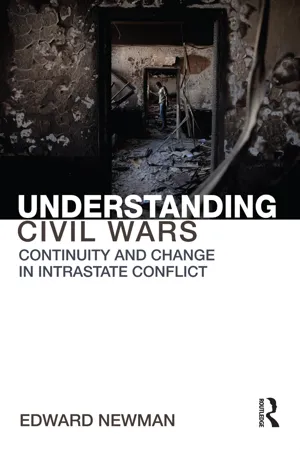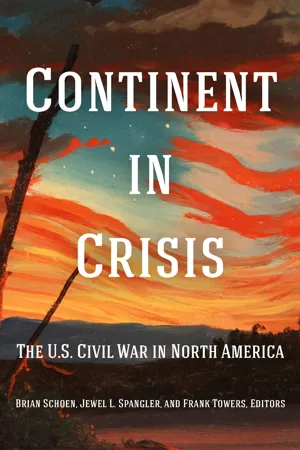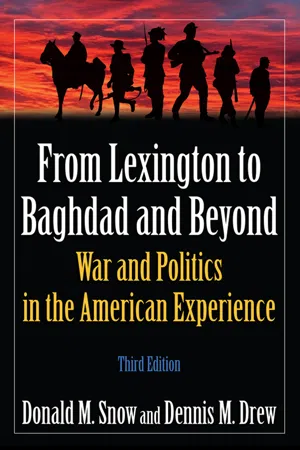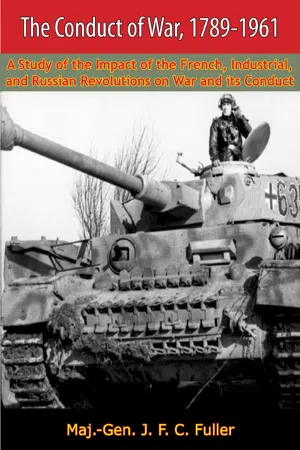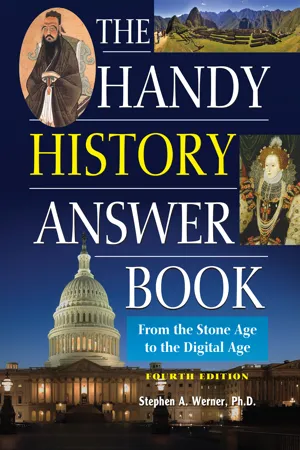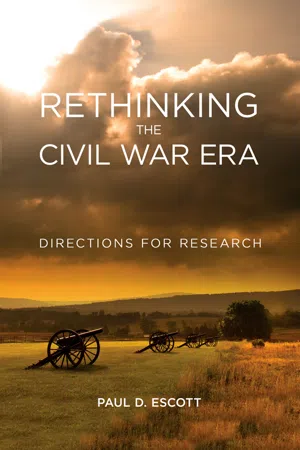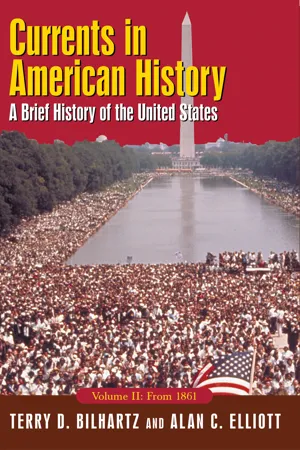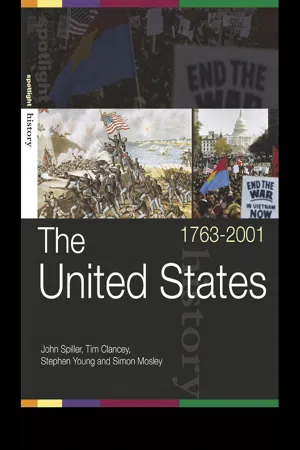History
The American Civil War
The American Civil War was a major conflict fought from 1861 to 1865 between the Northern states (Union) and the Southern states (Confederacy) over issues including slavery, states' rights, and the preservation of the Union. The war resulted in significant loss of life and ultimately led to the abolition of slavery in the United States with the Union emerging victorious.
Written by Perlego with AI-assistance
Related key terms
11 Key excerpts on "The American Civil War"
- eBook - ePub
Understanding Civil Wars
Continuity and change in intrastate conflict
- Edward Newman(Author)
- 2014(Publication Date)
- Routledge(Publisher)
The American Civil War 1861–65The American Civil War of 1861–65 has been described as the first ‘industrial’ war.1 Its scale, human impact and the implications that it had for international politics mark it as one of the defining civil wars. The conflict is generally portrayed as a clash of interests and values between northern and southern states, underscored by divergent economic, racial and cultural systems.2 However, there is no single, objective account of the meaning and nature of The American Civil War. There are conflicting narratives about the most fundamental questions of the conflict, including its causes and consequences, issues of conduct and justice, and its legacy. Debates about the civil war are often, in the United States at least, characterized by differing ideological perspectives and perennial controversies, such as the balance between local and federal authority, and the nature of southern and northern identity, amongst other things.3 Even its name can be a source of controversy. Whilst the ‘American Civil War’ is now the prevailing description, at the time of the conflict the terms ‘War of the Rebellion’ or ‘War for Southern Independence’ were commonplace, and interpretations of the conflict are still often contested.4 In the south the conflict was for many participants and observers a second war of independence, or a second revolution; from a northern perspective it was a struggle to maintain the integrity of the American project and everything for which the founding fathers had fought. Above all, the debate about the causes of the conflict has been beset by differences in interpretation and historical revisionism.5 - eBook - ePub
Continent in Crisis
The U.S. Civil War in North America
- Brian Schoen, Jewel L. Spangler, Frank Towers(Authors)
- 2023(Publication Date)
- Fordham University Press(Publisher)
The American Civil War took place at the pivot toward what Charles Maier has called Leviathan 2.O. 9 As the essays in this volume demonstrate, seeking sovereignty inevitably brought the question of using other sovereigns and interstate relations as means to fulfilling that ambition. At multiple levels of the conflict, protagonists in the Civil War advanced competing sovereign claims. Those claims went beyond whether or not the United States would prevail over the Confederacy to encompass questions such as federalism’s divided powers, citizenship and its rights, Indigenous-settler relations in the West, and international diplomacy. In each case, an outcome in one arena—for example, successes or failures in conquering Native peoples—said something about the extent of the nation-state’s sovereign claims overall. Battles in one of these areas could reframe developments elsewhere. When viewed in its North American context, the Civil War’s many battles over sovereignty can be understood not as intrinsically American issues but rather as part of regional and global negotiation of the right to rule. 10 The foregoing claims about the transnational dimensions of the U.S. Civil War may seem odd to Americans used to thinking about that conflict as a fundamentally national story focused on the internal character of the United States. Within that framework, the Civil War is a key plot point in America’s national development. In that narrative, an imperfect founding left the nation half slave and half free, a contradiction in the national character that had to be resolved one way or another. Its resolution in a bloody war that purged the nation of the sin of slavery fits into a redemptive story of sacrifice in the name of progress. That view shaped public memory and found more muted expression in professional scholarship for much of the twentieth century - eBook - ePub
From Lexington to Baghdad and Beyond
War and Politics in the American Experience
- Donald M Snow, Dennis M. Drew(Authors)
- 2015(Publication Date)
- Routledge(Publisher)
3CIVIL WARThe American Civil War represents the greatest American national trauma. It was the first conflict in the American experience that clearly and unambiguously met the dual criteria of total war. The issue of union or disunion of the country was all-encompassing and could be resolved only on the field of battle, and the war became a match between totally mobilized societies. The result was the bloodiest war in American history. When the last gunpowder haze rose and Robert E. Lee and Joseph E. Johnston surrendered the remnants of their armies, more than 600,000 had died and nearly another 500,000 had been wounded. And it had all been done at our own hand.In many ways the Civil War was warfare in transition, a junction between the classical conflicts of the eighteenth century and the massive carnage of the twentieth century. Tactically, battles were organized and fought along the lines of the Napoleonic campaigns by armies led by officers who had learned to fight that way at West Point, and both sides (especially Lee’s) were obsessed with the “decisive battle” concept integral to Napoleon’s success.At the time no one really appreciated how the face of war was changing. Partly this was the case because it was a war fought and led by men who were largely inexperienced in combat when it began. The soldiers available were largely untrained militia (in the American tradition) who could neither drill nor, in many cases, fire a gun. The war’s first major battle, First Manassas (Bull Run), showed both sides how poorly prepared they were for the war and how difficult the task would be. After First Manassas both sides mobilized their societies, and in the following spring when the real fighting began, war machines of unprecedented size were ready to grind against one another and produce equally unprecedented carnage. - eBook - ePub
The Story of Religion in America
An Introduction
- James P. Byrd, James Hudnut-Beumler(Authors)
- 2021(Publication Date)
- Westminster John Knox Press(Publisher)
9. Slavery and the Civil WarThe Civil War (1861–65) was the most catastrophic war in American history: over 700,000 Americans died. Through all the devastation, Americans looked to God and the Bible for support and consolation. For both the Union and the Confederacy, it was a sacred war, and slavery was at the center of it. Although various issues surrounded the war, including states’ rights and loyalty to the Union, the main cause was the conflict over slavery. Nobody knew this better than Abraham Lincoln. In his Second Inaugural Address, delivered near the end of the war, he said it clearly: “Slaves constituted a peculiar and powerful interest. All knew that this interest was somehow the cause of the war.”1Most Americans agreed that slavery was inseparable from religion. Some called it God’s blessing, destined to enrich the South and to bring the gospel to “heathen” Africans; others called slavery the nation’s curse, a diabolical institution that offended God and made a mockery of the nation’s claim to be a land of liberty. Americans divided over slavery; they claimed God’s endorsement for their views, transforming them into sacred convictions worth fighting (and dying) for by the hundreds of thousands. American views of religion, violence, and the nation’s mission would never be the same.Slavery and the Nation’s FoundingAs we have seen, the American Revolution tragically failed to abolish slavery. A new nation that claimed to be based on the principles of human equality and natural rights supported the enslavement of human beings. Recognizing this glaring contradiction, several prominent founders claimed that slavery was on the road to extinction. For much of the founding era, slavery was the elephant in the room—constantly thought about, sometimes complained about, but ignored whenever possible. The Constitution said nothing about freeing enslaved people, and it protected the slave trade until 1808. This was a relief for the founders, who wanted to put off the issue and let future leaders deal with it. Besides, many consoled themselves with the idea that slavery would die away on its own, so they did not want to argue about it. Best to wait until after 1808, when the nation would no longer participate in the international slave trade, and surely the end of slavery in the nation would follow.2 - eBook - ePub
The Conduct of War, 1789-1961
A Study of the Impact of the French, Industrial, and Russian Revolutions on War and its Conduct
- Maj.-Gen J. F. C. Fuller(Author)
- 2018(Publication Date)
- Arcole Publishing(Publisher)
CHAPTER VI — The American Civil War 1861–1865
1. Impact of the Industrial Revolution on the United States
The American Civil War was the first great conflict of the steam age, and its origins were intimately related to the impact of the Industrial Revolution on what Marx calls the ‘productive forces’ prevalent in the youthful United States. This led to a change in ‘productive relations’, and ultimately to war between two variant economic societies—the inhabitants of the Northern States and those of the Southern. While the former were staunch democrats, mainly occupied in agriculture and commerce, the latter were an aristocratically-minded people, almost feudal in outlook, whose plantations were cultivated by slave labour.Although during the War of Independence (1775–1783), or immediately after, the founding fathers of the Union reprobated slavery, when, in 1787, the Constitution was drafted, on the insistence of South Carolina and Georgia slavery was retained.{184} As things then stood, slavery was on the decline, and had the ‘productive forces’ remained as they were, the probability is that, within a generation or two, slavery would have withered away.This was not to be, because four years after the ratification of the Constitution in 1788, suddenly there appeared an invention which was enormously to stimulate the cultivation of cotton in the Southern States. In 1792, Eli Whitney, an American, designed his ‘saw gin’ for separating cotton from the seed, and it made cotton so profitable that between 1815 and 1861 it became known as ‘King of the Southern States’. Coincidentally this placed slave labour on a highly profitable footing, with the result that, instead of slaves being a drug on the market, their supply fell short of demand. Prior to the introduction of the saw gin, tobacco, more so than cotton, had been the staple crop of the South, but by 1820 the cotton crop had risen to 160 million pounds; ten years later it had doubled, in 1850 it passed the 1,000 million pounds mark, and in 1860 it stood at 2,300 million pounds. Concurrently, the price of a ‘prime field hand’ rose from about $500 in 1830 to about $1,800 in 1860, which shows how vital their supply had become to the prosperity of the South. - eBook - ePub
The Handy History Answer Book
From the Stone Age to the Digital Age
- Stephen A. Werner(Author)
- 2020(Publication Date)
- Visible Ink Press(Publisher)
Abraham Lincoln (1809–1865) was elected president in November 1860. Very quickly, Southern states started to secede, fearing that Lincoln would jeopardize slavery despite the fact that Lincoln supported the idea of continuing to allow slavery in those states that already had it. South Carolina was the first (in December of that year). In January 1861, five more states followed: Mississippi, Florida, Alabama, Georgia, and Louisiana. When representatives from the six states met the next month in Montgomery, Alabama, they established the Confederate States of America and elected Mississippi senator Jefferson Davis (1808–1889) president. Two days before Lincoln’s inauguration, Texas joined the Confederacy. (Virginia, Arkansas, North Carolina, and Tennessee joined in April, shortly after the Civil War had already begun.)The Civil War began on April 12, 1861, when Southern troops fired on Fort Sumter, a U.S. military post in Charleston, South Carolina. Brutal fighting would continue for four years. On April 9, 1865, General Robert E. Lee (1807–1870) surrendered his ragged Confederate troops to General Ulysses S. Grant (1822–1885) of the Union at Appomattox Court House, Virginia. The war had not only been between the states, it had also been between brothers: the conflict divided the nation. The Civil War took more American lives than any other war in American history.A photo taken in 1863 shows a bombed-out Fort Sumter occupied by the Confederates.What are some of the more important battles of the Civil War?There were over 10,000 military confrontations ranging from small skirmishes to the major battles, fought in twentythree states. Between 620,000 and 750,000 soldiers died, which is more deaths than the combined total of deaths in all other American wars. In the Civil War, far more soldiers died from sickness—such as diarrhea and dysentery—than died from combat wounds. An estimated 50,000 civilians also died in the Civil War.Here are ten of the most important battles and military actions of the war:U.S. Civil War Events of Note - eBook - ePub
Rethinking the Civil War Era
Directions for Research
- Paul D. Escott(Author)
- 2018(Publication Date)
- The University Press of Kentucky(Publisher)
1Understanding the Roots of WarA fundamental part of Civil War studies has always been analysis of the causes of the war. Except for books about Lincoln and military history, which have included the work of many nonacademic historians, probably no other topic has attracted as much attention. And perhaps in no other area have change and progress been so great. The overall way that we try to understand the roots of the war is very different now from the way it was understood in the 1960s or 1970s.When I began graduate school, many important studies focused their attention on the events of the sectional conflict, the friction points that eventually led to civil war. Through careful research, historians tried to understand the sequence of North–South conflicts, how each collision affected the Union, and how these successive clashes aggravated the tensions that brought about secession. Some interpretations had a pro-Southern slant, whereas others showed more appreciation for abolitionists or Northern antislavery sentiment. If many scholars were moving away from James G. Randall’s earlier argument that a “blundering generation” of politicians caused a needless war, the focus of their attention had not changed. Their priority remained to elucidate the debates and crises that produced growing tension.The efforts of this period produced some outstanding research and trenchant analysis. If Roy Nichols previously had identified the way battles over the right to petition broadened into fear of a Slave Power, others such as Joel Silbey and Michael Holt offered important new insights about party realignment. To understand the actions of political leaders, we continue today to turn to studies of the Compromise of 1850 as well as of Henry Clay or Stephen Douglas or John C. Calhoun or others, and valuable studies of such prominent leaders continue to appear. One of the most enduring of all the political histories is David M. Potter’s book The Impending Crisis, 1848–1861.1 - eBook - ePub
Currents in American History: A Brief History of the United States, Volume II: From 1861
A Brief History of the United States, Volume II: From 1861
- Alan C. Elliott, Terry D. Bilhartz(Authors)
- 2023(Publication Date)
- Routledge(Publisher)
CHAPTER 7 A NATION DIVIDES, April 12, 1861 Fort Sumter and the Era of The American Civil WarBombardment of Fort Sumter, Charleston Harbor, April 12 and 13, 1861(Print by Currier & Ives. 1861. Library of Congress, Prints & Photographs Division, LC-USZ62-2570. 9-29-2006. http://hdl.loc.gov/loc.pnp/cph.3a06242 )Time LineB1852 Harriet Beecher Stowe publishes Uncle Tom's Cabin 1854 The Kansas-Nebraska Act revives bitter sectional animosities 1856 Civil War in Kansas James Buchanan is elected president 1857 U.S. Supreme Court rejects Dred Scott's appeal for freedom 1858 Abraham Lincoln challenges Senator Stephen Douglas to a series of debates 1859 John Brown attacks Harpers Ferry 1860 The Democratic Party splits Northern Democrats nominate Douglas Southern Democrats nominate John C. Breckinridge Carrying 39 percent of the popular vote, Lincoln wins the presidency South Carolina secedes from the Union 1861 Confederates fire on Fort Sumter Lincoln calls for volunteers to crush the rebellion 1862 Following the Battle of Antietam, Lincoln announces the Emancipation Proclamation 1863 The Gettysburg Campaigns claims over 50,000 casualties Lincoln delivers the Gettysburg Address 1864 Lincoln defeats McClellan to gain reelection 1865 Robert E. Lee surrenders at Appomattox Lincoln is assassinated Andrew Johnson becomes president The Thirteenth Amendment is ratified 1867 Andrew Johnson is impeached for violating the Tenure of Office Act 1868 The Fourteenth Amendment is ratified U.S. Grant is elected president 1870 The Fifteenth Amendment is ratified - Insight Guides(Author)
- 2022(Publication Date)
- Insight Guides(Publisher)
FROM THE WAR BETWEEN THE STATES TO WORLD WAR IIThe first modern war devastated a land that saw itself prosperous and powerful. It would be many, many years before the South would rise againAt the time, The American Civil War was a war like no other. It was the first real war of the industrial age; it was the first war in which armies were supplied by railway; it was the first war to be conducted by telegraph and so able to be reported quickly to civilian populations. It saw the introduction of the observation balloon, the repeating rifle (an early form of machine gun) and, at sea, the iron-clad, steam-powered warship. When it first began in the spring of 1861, there was much talk on both sides of a quick and neat conflict with the soldiers being home in time for Christmas.Storming Fort Wagner, 1863. Everett Collection/ShutterstockNaive Northerners saw it merely as a police action to curb the seemingly ungovernable South; naive Southerners boasted that one dashing young Southern cavalier could whip ten cowardly abolitionists. More thoughtful men on both sides, including Abraham Lincoln and Jefferson Davis, understood that the sectional controversies of four decades had aroused deep passions and that in all likelihood, once the war began, blood would flow until some final settlement was achieved.The American Civil War is considered the first modern war in history. Never before had a conflict been fed by railways, machine guns and steel sided battleships.Seeds of secessionThe intemperate economic arguments over tariffs that strained the Union in the 1850s, and the South’s reputation as the ‘wealth producing’ section of the country, giving reason to believe it could go it alone, went hand in hand with perceived moral and cultural rifts. Demand rose in the South for Southern textbooks and Southern teachers and for the South to emancipate itself from literary dependency on Northern and European writers.Confederate General Robert E. Lee.- eBook - ePub
Surveys from Exile
Political Writings
- Karl Marx(Author)
- 2020(Publication Date)
- Verso(Publisher)
1THE NORTH AMERICAN CIVIL WAR
London, 20 October 1861For months now the leading London papers, both weekly and daily, have been repeating the same litany on The American Civil War. While they insult the free states of the North, they anxiously defend themselves against the suspicion of sympathizing with the slave states of the South. In fact, they continually write two articles: one in which they attack the North, another in which they excuse their attacks on the North. Qui s’excuse, s’accuse.2Their extenuating arguments are basically as follow. The war between North and South is a tariff war. Furthermore, the war is not being fought over any issue of principle; it is not concerned with the question of slavery but in fact centres on the North’s lust for sovereignty. In the final analysis, even if justice is on the side of the North, does it not remain a futile endeavour to subjugate eight million Anglo-Saxons by force! Would not a separation from the South release the North from all connection with Negro slavery and assure to it, with its 20 million inhabitants and its vast territory, a higher level of development up to now scarcely dreamt of? Should the North not then welcome secession as a happy event, instead of wanting to crush it by means of a bloody and futile civil war?Let us examine point by point the case made out by the English press.The war between North and South – so runs the first excuse – is merely a tariff war, a war between a protectionist system and a free-trade system; and England, of course, is on the side of free trade. Is the slave-owner to enjoy the fruits of slave labour to the full, or is he to be cheated of part of these fruits by the Northern protectionists? This is the question at issue in the war. It was reserved for The Times to make this brilliant discovery; the Economist, Examiner, Saturday Review and the like have elaborated on the same theme. It is characteristic that this discovery was made, not in Charleston, but in London. In America everyone knew, of course, that between 1846 and 1861 a system of free trade prevailed and that Representative Morrill only carried his protectionist tariff through Congress after the rebellion had already broken out. Secession did not take place, therefore, because Congress had passed the Morrill tariff; at most, the Morrill tariff was passed by Congress because secession had taken place. To be sure, when South Carolina had its first attack of secessionism in 1832 the protectionist tariff of 1828 served as a pretext; but that a pretext is all it was is shown by a statement made by General Jackson. This time, however, the old pretext has in fact not been repeated. In the secession Congress at Montgomery3 - eBook - ePub
- Tim Clancey, Simon Mosley, John Spiller, Stephen Young(Authors)
- 2004(Publication Date)
- Routledge(Publisher)
Problems in American Civilisation, D.C. Heath (1993).Eric Foner, Free Soil, Free Labor, Free Men, Oxford University Press (1970). Quoted in Kenneth Stampp (ed.), The Causes of the Civil War, Touchstone (1991).Susan-Mary Grant, ‘For God and Country . . .’, History Today, issue 50 (7), July (2000).Michael Johnson (ed.), Abraham Lincoln, Slavery, and the Civil War – Selected Writings and Speeches, Bedford (2001).Brian Holden Reid, The Origins of The American Civil War, Longman (1996).Michael Holt, The Political Crisis of the 1850s, Norton (1978).Maldwyn Jones, The Limits of Liberty, Oxford University Press (1983/1995).James McPherson, Battle Cry of Freedom, Penguin (1990).James McPherson, For Cause and Comrades, Oxford University Press (1997).John M. Murrin, Paul E. Johnson, James M. McPherson et al., Liberty Equality Power, Harcourt (2001).Derrick Murphy, Kathryn Cooper and Mark Waldron, United States 1776–1992, Collins (2001).Russel B. Nye, Fettered Freedom, Michigan State University Press (1949). Quoted in Kenneth Stampp (ed.), The Causes of the Civil War, Touchstone, Simon & Schuster (1991), p. 20.Kenneth Stampp (ed.), The Causes of the Civil War, Touchstone, Simon & Schuster (1991).Hugh Tulloch, The Debate on The American Civil War Era, Manchester University Press (1999).Howard Zinn, A People’s History of the United States
Learn about this page
Index pages curate the most relevant extracts from our library of academic textbooks. They’ve been created using an in-house natural language model (NLM), each adding context and meaning to key research topics.
